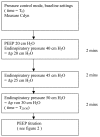Respiratory and haemodynamic changes during decremental open lung positive end-expiratory pressure titration in patients with acute respiratory distress syndrome
- PMID: 19374751
- PMCID: PMC2689506
- DOI: 10.1186/cc7786
Respiratory and haemodynamic changes during decremental open lung positive end-expiratory pressure titration in patients with acute respiratory distress syndrome
Abstract
Introduction: To investigate haemodynamic and respiratory changes during lung recruitment and decremental positive end-expiratory pressure (PEEP) titration for open lung ventilation in patients with acute respiratory distress syndrome (ARDS) a prospective, clinical trial was performed involving 12 adult patients with ARDS treated in the surgical intensive care unit in a university hospital.
Methods: A software programme (Open Lung Tool) incorporated into a standard ventilator controlled the recruitment (pressure-controlled ventilation with fixed PEEP at 20 cmH2O and increased driving pressures at 20, 25 and 30 cmH2O for two minutes each) and PEEP titration (PEEP lowered by 2 cmH2O every two minutes, with tidal volume set at 6 ml/kg). The open lung PEEP (OL-PEEP) was defined as the PEEP level yielding maximum dynamic respiratory compliance plus 2 cmH2O. Gas exchange, respiratory mechanics and central haemodynamics using the Pulse Contour Cardiac Output Monitor (PiCCO), as well as transoesophageal echocardiography were measured at the following steps: at baseline (T0); during the final recruitment step with PEEP at 20 cmH2O and driving pressure at 30 cmH2O, (T20/30); at OL-PEEP, following another recruitment manoeuvre (TOLP).
Results: The ratio of partial pressure of arterial oxygen (PaO2) to fraction of inspired oxygen (FiO2) increased from T0 to TOLP (120 +/- 59 versus 146 +/- 64 mmHg, P < 0.005), as did dynamic respiratory compliance (23 +/- 5 versus 27 +/- 6 ml/cmH2O, P < 0.005). At constant PEEP (14 +/- 3 cmH2O) and tidal volumes, peak inspiratory pressure decreased (32 +/- 3 versus 29 +/- 3 cmH2O, P < 0.005), although partial pressure of arterial carbon dioxide (PaCO2) was unchanged (58 +/- 22 versus 53 +/- 18 mmHg). No significant decrease in mean arterial pressure, stroke volume or cardiac output occurred during the recruitment (T20/30). However, left ventricular end-diastolic area decreased at T20/30 due to a decrease in the left ventricular end-diastolic septal-lateral diameter, while right ventricular end-diastolic area increased. Right ventricular function, estimated by the right ventricular Tei-index, deteriorated during the recruitment manoeuvre, but improved at TOLP.
Conclusions: A standardised open lung strategy increased oxygenation and improved respiratory system compliance. No major haemodynamic compromise was observed, although the increase in right ventricular Tei-index and right ventricular end-diastolic area and the decrease in left ventricular end-diastolic septal-lateral diameter during the recruitment suggested an increased right ventricular stress and strain. Right ventricular function was significantly improved at TOLP compared with T0, although left ventricular function was unchanged, indicating effective lung volume optimisation.
Figures





References
-
- Dreyfuss D, Saumon G. Ventilator-induced lung injury: lessons from experimental studies. Am J Respir Crit Care Med. 1998;157:294–323. - PubMed
-
- Maggiore SM, Jonson B, Richard JC, Jaber S, Lemaire F, Brochard L. Alveolar derecruitment at decremental positive end-expiratory pressure levels in acute lung injury: comparison with the lower inflection point, oxygenation, and compliance. Am J Respir Crit Care Med. 2001;164:795–801. - PubMed
-
- Webb HH, Tierney DF. Experimental pulmonary edema due to intermittent positive pressure ventilation with high inflation pressures. Protection by positive end-expiratory pressure. Am Rev Respir Dis. 1974;110:556–565. - PubMed
-
- Meade MO, Cook DJ, Guyatt GH, Slutsky AS, Arabi YM, Cooper DJ, Davies AR, Hand LE, Zhou Q, Thabane L, Austin P, Lapinsky S, Baxter A, Russell J, Skrobik Y, Ronco JJ, Stewart TE, Lung Open Ventilation Study Investigators Ventilation strategy using low tidal volumes, recruitment maneuvers, and high positive end-expiratory pressure for acute lung injury and acute respiratory distress syndrome: a randomized controlled trial. JAMA. 2008;299:637–645. doi: 10.1001/jama.299.6.637. - DOI - PubMed
Publication types
MeSH terms
LinkOut - more resources
Full Text Sources

